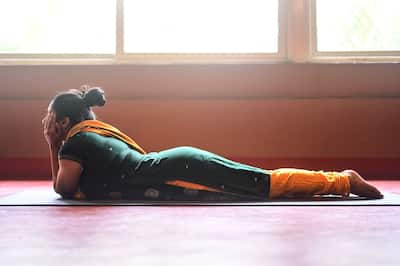Don’t Miss Out on the Latest Updates.
Subscribe to Our Newsletter Today!
Crocodile Pose (Makarasana): How To Practice, Benefits And Precautions

Makarasana, which is best performed on an empty stomach first thing in the morning, cleans the intestines.
Makarasana Crocodile Pose: The crocodile position, also known as Makarasana, is a therapeutic or healing position helpful in transitioning between postures that strengthen the back. Makarasana, also known as the crocodile posture, is the final yoga pose because it calms the entire nervous system. As your body cools down in this position, you may get the rest you need. It is an adaptation of the locust stance or shalabhasana. This position is beneficial for managing stress, maintaining good posture, and being refreshing and soothing. There are suggestions that this posture may benefit the muscles in the buttocks, backs of the arms and legs, and legs. Makarasana, which is best performed on an empty stomach first thing in the morning, cleans the intestines. If not in the morning, you can do it three to four hours after your last meal in the evening.
Step-by-Step Formation Of Makarasana By Yoga and Spiritual Leader, Himalayan Siddhaa Akshar, Founder Of Akshar Yoga Institutions
- Join your elbows together and form a lotus shape with your palms.
- Maintain an upward position with your fingers.
- Raise your head and shoulders while maintaining a straight posture and forward gaze.
- Tuck your chin between your palms.
- Your toes are pointed outward, and your legs are extended.
- Take a regular, steady breath to help your muscles relax.
- Remain in the pose until you feel entirely at ease.
- To release, turn over, pull your shoulders and head down, and gently remove your palms from your chin.
Also Read
Benefits Of Makarasana
- It prevents backaches, enables you to breathe deeply and gently, keeps you awake, and loosens tight muscles to make them more flexible.
- For some forms of lower back discomfort, Makarasana may be beneficial. It has been observed that patients who experience sciatica (hip and leg pain emanating from the sciatic nerve), a slipped disc, or lower back discomfort may find relief after adopting the crocodile position.
- Asthma, knee discomfort, and other lung-related conditions may all be treated with Makarasana.
- It also helps treat slipped discs, spondylitis, and sciatica.
- It stretches out the hip muscles.
- It keeps you feeling refreshed. It reduces stress, treats heart disease and hypertension, and stretches the neck, chest, and belly muscles, alleviating pain and weariness in those regions.
- The crocodile position might ease lower-body muscles, activate the sacrum, a triangle bone between the hips, and support the spine. This could improve the flow of prana (life energy) and help clear obstructions. Overall, it may help with self-control and have a soothing impact on the body's muscles.
- The body's need for oxygen may be reduced due to this calming impact, further promoting calm.
Precautions To Be Taken
If you have a significant back injury, stay away from this position. For individuals with neck ailments, wrap a folded blanket around their necks during the asana to provide support. By doing so, you can protect your neck from any pressure or help.



